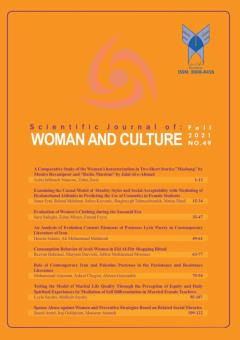واکاوی سیر تحول عناصر محتوایی غزل و شعر زنان معاصر ایران
الموضوعات : Persian the literatureحسین سلیمی 1 , علی محمد محمودی 2
1 - دانشگاه خلیج فارس بوشهر، گروه زبان و ادبیات فارسی، بوشهر، ایران.
2 - دانشگاه سلمان فارسی کازرون، گروه زبان و ادبیات فارسی، کازرون، ایران.
الکلمات المفتاحية: شعر, تحول غزل, زنان شاعر معاصر,
ملخص المقالة :
هدف پژوهش حاضر واکاوی سیر محتوایی تحول غزل و شعر زنان معاصر ایران میباشد. جامعه مورد بررسی شعر و غزل زنان از عهد مشروطه تا آغاز دهۀ نود معاصر است. نمونه پژوهش شعر ژاله قایم مقامی، شعر و غزل سیمین بهبهانی و فروغ فرخزاد بود. طرح پژوهش توصیفی-تحلیلی و گردآوری اطلاعات از طریق کتابخانه ای و منابع پژوهشی دیجیتالی انجام شد. برای تحلیل از شیوه جریانشناسی شخصیت محور محتوای غزل زنان و سیر مهمترین تحولات آن در بستر تاریخ معاصر استفاده شد. نتایج نشان داد، کلیت و کیفیت شعر زنان در این دوره رو به کمال بود. غزل زنان ایران معاصر، پس از غزل سیمین بهبهانی و فروغ فرخزاد به سمت افقهای نو و آزاداندیشانه ای حرکت کرده است که از میان جریانهای فکری درون فرهنگی و برون فرهنگی ایران، دو نوع غزل متعهد، اجتماعمحور و غزل پست مدرن و گاه نیز غزل زبانگرای ساختارشکن بیشترین سهم را دارد. غزل زنان نیز هم چون شعر آزاد نیمایی مجال بروز عواطف زنانه را یافته و غزل از حالت کلاسیک و یک صدایی به جریانها و صداهای متعددی وارد شده است. مطالعۀ غزل زنان در این صدسال یعنی مطالعۀ صدسال جامعهشناختی شعر زنان و به تبع آن جامعه ایرانی است.


